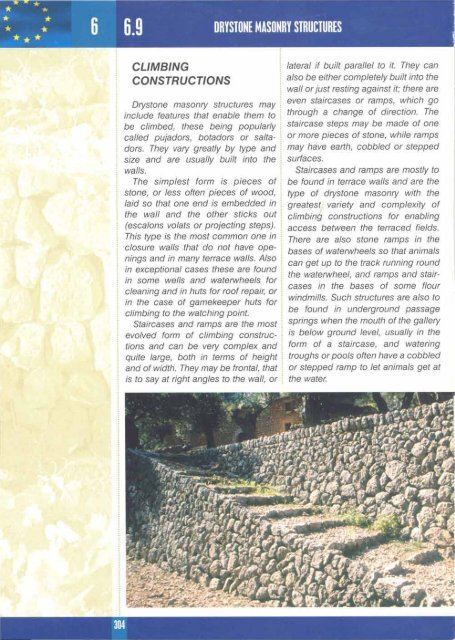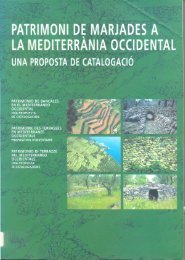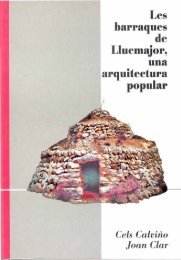- Page 2 and 3:
... ~Consell de ~ Mallorca • Depa
- Page 4 and 5:
Chapter 1 - The dry-stone in the me
- Page 6 and 7:
• 5.12 Cobbling 141 • 5. 13 Roo
- Page 8 and 9:
8 This volume, one of the publicati
- Page 12 and 13:
*** *: 1 THE DRY -STONE IN THE MEDI
- Page 14 and 15:
*** * • * 1 THE DRY -STONE IN THE
- Page 16 and 17:
*** I : 1 THE DRY -STONE IN THE MED
- Page 18 and 19:
*** * ** 1 THE DRY -STONE IN THE ME
- Page 22 and 23:
*** * * * 2 * * THE MARGER *** THE
- Page 24 and 25:
*** * * : 2 THE MARGER *** out. The
- Page 26 and 27:
*** * * : 2 THE MARGER *** and 20th
- Page 30 and 31:
* *** * * ** ** * 3 THE RAW MATERIA
- Page 32 and 33:
not available or it was not wanted
- Page 34 and 35:
*** * * : * * *: 3 3.1 THE RAW MATE
- Page 36 and 37:
*** * * * * *: 3 3.2 THE RAW MATERI
- Page 38 and 39:
*** * ' * * *** 3 3.3 THE RAW MATER
- Page 40 and 41:
*** * * **: 3 3.4 THE RAW MATERIAL
- Page 42 and 43:
*** I * * 1 * 3 3.5 THE RAW MATERIA
- Page 44 and 45:
Scientific name Gypsum Description
- Page 46 and 47:
**. • .* * *** 3 3.7 THE RAW MATE
- Page 48 and 49:
*** * * ** *: 3 3.8 THE RAW MATERIA
- Page 50 and 51:
*** * * * *: 3 3.9 THE RAW MATERIAL
- Page 52 and 53:
HONEY COMBLED STONE Scientific name
- Page 54 and 55:
STONE SLAB Scientific name Stone sl
- Page 56 and 57:
*** * **: 3 3.12 THE RAW MATERIAL C
- Page 60 and 61:
**. ** 4 * * ** THE TOOLS Margers u
- Page 62 and 63:
*** * * 4 THE TOOLS *** and locate
- Page 64 and 65:
*** . * ,j : 4 4 1 THE TOOLS . ***
- Page 66 and 67:
*** * .* * *: 4 4.2 THE TOOLS i(M~i
- Page 68 and 69:
*** * : 4 4 3 THE TOOLS . *** . Des
- Page 70 and 71:
*** * * * *: 4 4.4 THE TOOLS Descri
- Page 72 and 73:
*** 11< * * *.* 4 4.5 THE TOOLS Des
- Page 74 and 75:
*** * * *: 4 4.6 THE TOOLS * Descri
- Page 76 and 77:
Description A tool consisting of a
- Page 78 and 79:
*** * ** *: 4 4.8 THE TOOLS Descrip
- Page 80 and 81:
Description An iron bar with a bent
- Page 82 and 83:
**. * * *-* * * *** 4 4.10 THE TOOL
- Page 84 and 85:
*** . * * \ * * *: 4 4.11 THE TOOLS
- Page 86 and 87:
*** * * :* * * ** 4 4.12 THE TOOLS
- Page 88 and 89:
* * * * * * * ** 4 4.13 THE TOOLS D
- Page 90 and 91:
*** * * **: 4 4.14 THE TOOLS GjftT
- Page 92 and 93:
Description A recipient wider in th
- Page 94 and 95:
*** * .* * *: 4 4.16 THE TOOLS Desc
- Page 96 and 97:
*** * .* * *** 4 4.17 THE TOOLS Des
- Page 98 and 99:
*** * ** 4 4.18 THE TOOLS I *** , D
- Page 100 and 101:
* * * * * * *.* 4 4.19 THE TOOLS De
- Page 102 and 103:
*** 11< * * *: 4 4.20 THE TOOLS Des
- Page 104 and 105:
*** .,. •* * *** 4 4.21 THE TOOLS
- Page 106:
*** * ** 4 4.21 THE TOOLS *** I C=-
- Page 109 and 110:
xelat en els murs de sustentacio de
- Page 111 and 112:
Descripci6 L'espedregament 0 retira
- Page 114 and 115:
*** .• * * *: 5 5.2 THE WORK 114
- Page 116 and 117:
*** * I : 5 5 3 THE WORK : * * * .
- Page 118 and 119:
DIGGING FOUNDATION TRENCHES Definit
- Page 120 and 121:
*** * * **: 5 5.5 THE WORK Definiti
- Page 122 and 123:
Definition To lay securely the firs
- Page 124 and 125:
*** * * * *: 5 5.7 THE WORK Definit
- Page 126 and 127:
*** * ** * ** 5 5.7 THE WORK mer an
- Page 128 and 129:
*** * * * *: 5 5.7 THE WORK height
- Page 130 and 131:
130 slope is created by stepping th
- Page 132 and 133:
I **. I • ' * / 5 5.8 mE WORK I *
- Page 134 and 135:
**. * ! * 5 5.9 THE WORK I *** ;I B
- Page 136 and 137:
*** .• :* * *: 5 5.10 THE WORK De
- Page 138 and 139:
**. * * * *: 5 5.11 THE WORK Defini
- Page 140 and 141:
*** * * : 5 5.11 THE WORK *** tfJfj
- Page 142 and 143:
*** * * **: 5 5.12 THE WORK 142 cen
- Page 144 and 145:
*** * * * *: 5 5.13 THE WORK ' 144
- Page 146 and 147:
ROOFING WITH A FRAME AND STONE SLAB
- Page 148 and 149:
*** * ***** 5 5.14 THE WORK sera tr
- Page 150 and 151:
*** . * I * : * 5 5.15 THE WORK i *
- Page 152 and 153:
*** * * * *: 5 5.16 THE WORK Defini
- Page 156 and 157:
*** * * * ** 6 DRYSTONE MASONRY STR
- Page 158 and 159:
*** * : 6 6.1 DRYSTONE MASONRY STRU
- Page 160 and 161:
*** ** 6 * DRYSTONE MASONRY STRUCTU
- Page 162 and 163:
*** * , * * *: 6 6.1.1 DRYSTONE MAS
- Page 164 and 165:
*** ! * I * * *** 6 6.1.1 DRYSTONE
- Page 166 and 167:
• Exemple 2
- Page 168 and 169:
*** * ** 6 6.2 DRYSTONE MASONRY STR
- Page 170 and 171:
**. * * * * ** 6 6.2.1 DRYSTONE MAS
- Page 172 and 173:
*** * :* **: 6 6.2.2 DRYSTONE MASON
- Page 174 and 175:
*** * * * *: 6 6.2.3 DRYSTONE MASON
- Page 176 and 177:
*** * :* * *: 6 6.2.3 DRYSTONE MASO
- Page 178 and 179:
*** * * **: 6 6.2.4 DRYSTONE MASONR
- Page 180 and 181:
** * * *** 6 6.2.5 DRYSTONE MASONRY
- Page 182 and 183:
** * * * * ** 6 6.2.6 DRYSTONE MASO
- Page 184 and 185:
*** * * * *: 6 6.2.7 DRYSTONE MASON
- Page 186 and 187:
** * * *: 6 6.2.8 DRYSTONE MASONRY
- Page 188 and 189:
** * I * * *: 6 6.2.8 DRYSTONE MASO
- Page 190 and 191:
** * * *: 6 6.3 DRYSTONE MASONRY ST
- Page 192 and 193:
*. * * *: 6 6.3 DRYSTONE MASONRY ST
- Page 194:
* * * I * * *: 6 6.3.1 DRYSTONE MAS
- Page 197 and 198:
Descripci6 Clot excavat per arribar
- Page 199 and 200:
Descripcio Clot excavat per arribar
- Page 201 and 202:
Descripcio Sistema que aprofita la
- Page 203 and 204:
Descripcio Galeria pared ada, excav
- Page 206 and 207:
*** * , * *** 6 6.3.5 DRYSTONE MASO
- Page 208 and 209:
*** * * * *: 6 6.3.6 DRYSTONE MASON
- Page 210 and 211:
* * i * * * * *** 6 6.3.7 DRYSTONE
- Page 212 and 213:
*** * * -:* * *: 6 6.3.8 DRYSTONE M
- Page 214 and 215:
*** * * * * *: 6 6.3.9 DRYSTONE MAS
- Page 216 and 217:
*** * * * ** * ** 6 6.4 DRYSTONE MA
- Page 218 and 219:
*** * :* * *: 6 6.4.1 DRYSTONE MASO
- Page 220:
*** I! * t : 6 6.4.1 DRYSTONE MASON
- Page 223 and 224:
ELEMENTS DE CONSTHUCCIO DE PEDHA EN
- Page 225 and 226:
Descripci6 Conduccia d'aigua entre
- Page 228 and 229:
*** * * :* * *** 6 6.4.3 DRYSTONE M
- Page 230 and 231:
*** * :* * *: 6 6.4.4 DRYSTONE MASO
- Page 232 and 233:
*** * .** *: 6 6.4.5 DRYSTONE MASON
- Page 234 and 235:
*** * * * *: 6 6.5 DRYSTONE MASONRY
- Page 236 and 237:
*** ** * * ** 6 6.5 DRYSTONE MASONR
- Page 238 and 239:
*** * * * *: 6 6.5.1 DRYSTONE MASON
- Page 240 and 241:
• rorIO d~"~vm~r • Porxo de Nev
- Page 242 and 243:
*** * * * *: 6 6.5.3 DRYSTONE MASON
- Page 244 and 245:
*** * * * *: 6 6.5.3 DRYSTONE MASON
- Page 246 and 247:
*** * ' :** *: 6 6.5.4 DRYSTONE MAS
- Page 248 and 249:
*** * . * * *: 6 6.5.4 DRYSTONE MAS
- Page 250 and 251:
*** * ** 6 6.6 DRYSTONE MASONRY STR
- Page 252 and 253:
*** * * **: 6 6.6 DRYSTONE MASONRY
- Page 254 and 255: o 1m. I ••••• Openings Th
- Page 256 and 257: *** ; * ; * * *: 6 6.6.1 DRYSTONE M
- Page 258 and 259: * * * . ' * • . .* *•.* 6 6.6.1
- Page 260 and 261: *** * * : * * *: 6 6.6.2 DRYSTONE M
- Page 262 and 263: ca de carboner
- Page 264 and 265: *** * * :* **: 6 6.6.3 DRYSTONE MAS
- Page 266 and 267: 266 Roofing False dome made of flat
- Page 268 and 269: Outside the roof has a stepped appe
- Page 270 and 271: piece of stone, save the outside do
- Page 272 and 273: *** * * * * *: 6 6.6.4 DRYSTONE MAS
- Page 274 and 275: * I • . * *** 6 6.6.4 DRYSTONE MA
- Page 276 and 277: ** * * *: 6 6.6.5 DRYSTONE MASONRY
- Page 278 and 279: ** * *: 6 6.6.5 DRYSTONE MASONRY ST
- Page 280 and 281: ** * **: 6 6.6.6 DRYSTONE MASONRY S
- Page 282 and 283: ** * * *** 6 6.6.6 DRYSTONE MASONRY
- Page 284 and 285: ** * ** 6 6.7 DRYSTONE MASONRY STRU
- Page 286 and 287: Description Track that people and p
- Page 288 and 289: ** * * * ** 6 6.7.1 DRYSTONE MASONR
- Page 290 and 291: *** * * -:* * *** 6 6.7.1 DRYSTONE
- Page 292: *** * * * **: 6 6.7.1 DRYSTONE MASO
- Page 295 and 296: Materials Pedra viva. Tipus de ferm
- Page 297 and 298: Descripcio eamf transitable per a c
- Page 299 and 300: ELEMENTS DE CONSTHUCCIO DE PEDHA EN
- Page 301 and 302: 6 8 ELEMENTS D'ACUMULACIO • DE PE
- Page 303: I STONE STORAGE STRUCTURES Descript
- Page 307 and 308: ELEMENTS DE CONSTHUCCIO DE PEDHA EN
- Page 309 and 310: , ELEMENTS DE CONSTHUCCIO DE PEDHA
- Page 311 and 312: ELEMENTS DE CONSTRUCCIO DE PEDRA EN
- Page 313 and 314: ELEMENTS DE CONSTHUCCIO DE PEDHA EN
- Page 315 and 316: CANYELLES, N. (1997) EI paisatge de




